The Organists' Toolkit
A Guide for Reluctant Organists
Keyboards (or Manuals)
Essentially, there's no difference between a piano keyboard and an organ manual. Organ manuals, however, are shorter, starting just two octaves below middle C and only ranging upwards for five octaves.
The main differences are that they are not touch-sensitive (no matter how hard you strike the keys, the volume remains the same) and the sound doesn't die away (as long as you hold the key,
the note will sound).

Some organs have two manuals (called Swell and Great from top to bottom),
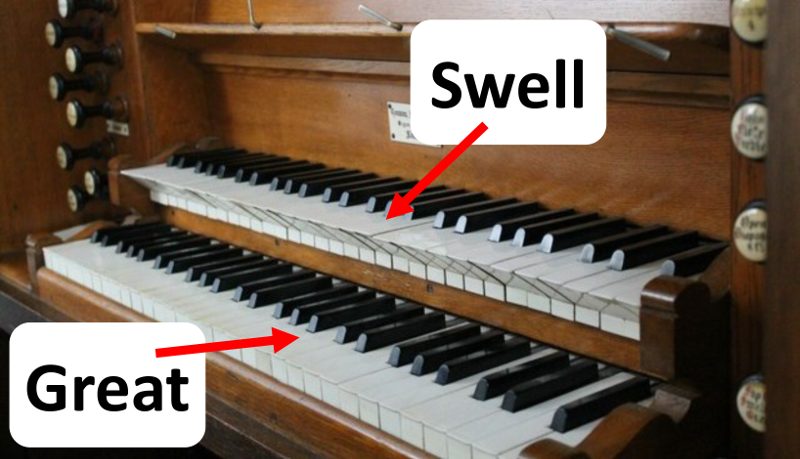
and others have three (Swell, Great, and Choir).
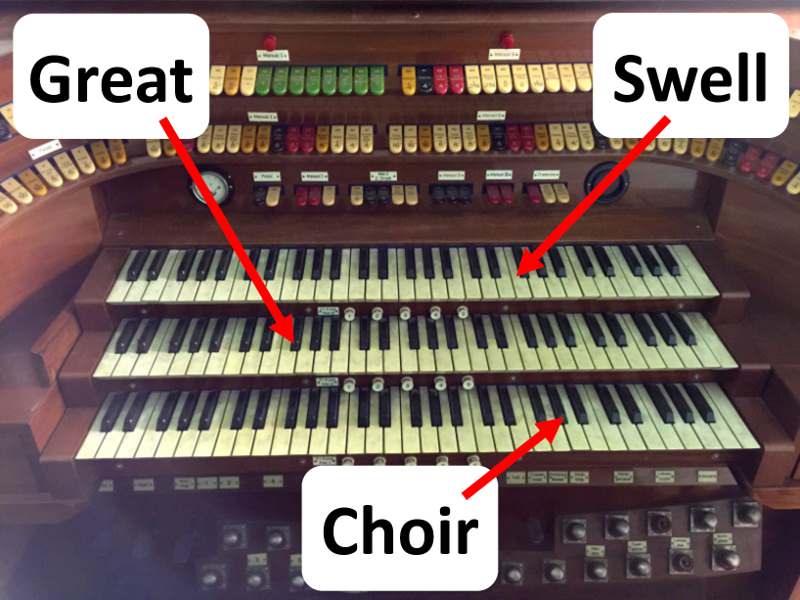
It's not necessary to use all the manuals, and quite possible to play satisfactory accompaniments on just one manual (in which case, choose the Great).
You're not likely to run across an organ with four or more manuals but, if you do, the extra manual(s) is likely to be the uppermost, so the lower three, from top to bottom, would be Swell, Great, Choir.
RETURN TO:
TOP
MENU - Organists Toolkit
MENU - Organists Online
The Stops
The stops provide the different tone colours and can vary between very quiet and very loud. Each stop controls a group (or RANK) of pipes.
The longer pipes produce the lower notes and the shorter pipes the higher notes.
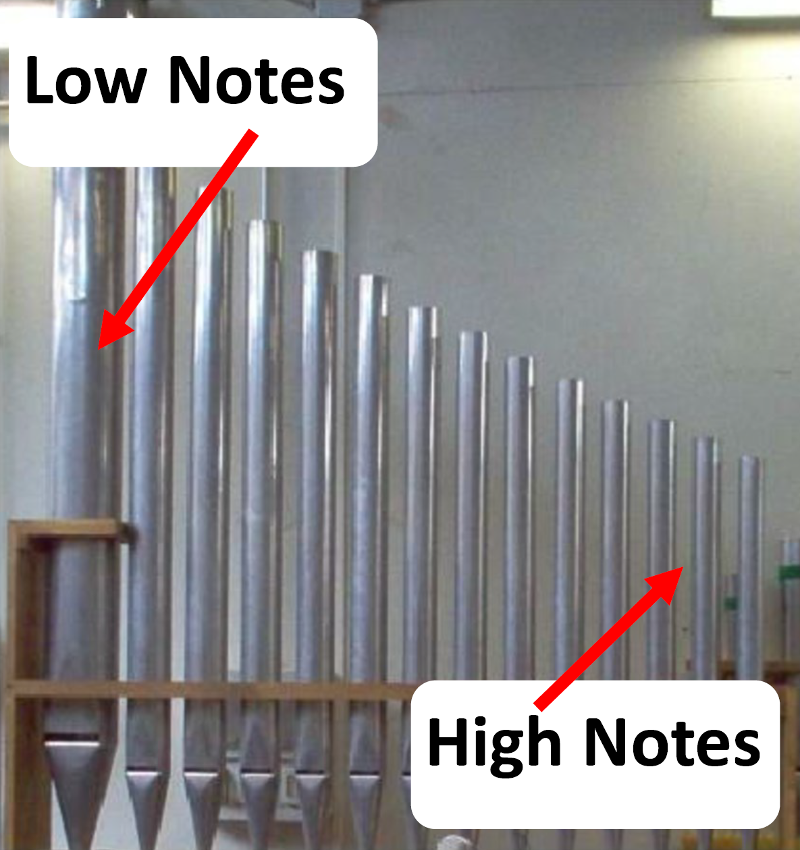
To produce sounds at concert pitch (give or take a little ) the length of the pipe for the lowest manual note is about 8 feet. In the organ world, notes around concert pitch are said to be
"at 8 foot pitch". (This is universal across the world. The metric system isn't used.)
With some ranks, the longest pipe is only 4 feet long. The whole rank sounds an octave above concert pitch and the rank is said to be "at 4 foot pitch".
Here, you can listen to Middle C played on an 8' stop, and then on a 4' stop.
With others, the longest pipe is only 2 feet long (at 2 foot pitch) and sounds two octaves above concert pitch.
And here, Middle C on an 8' stop and then a 2' stop.
I'll leave you to work out for yourself what a 16' stop does.
Click here for the answer
To complicate matters, some stops have fractional pipe lengths (2-2/3 feet, or 1-3/5 feet). More of this later. But you can decide right now, if you like, to ignore this complication.
It's not necessary to use these stops.
The stops themselves can be either drawstops (which have to be pulled out to activate the pipes),
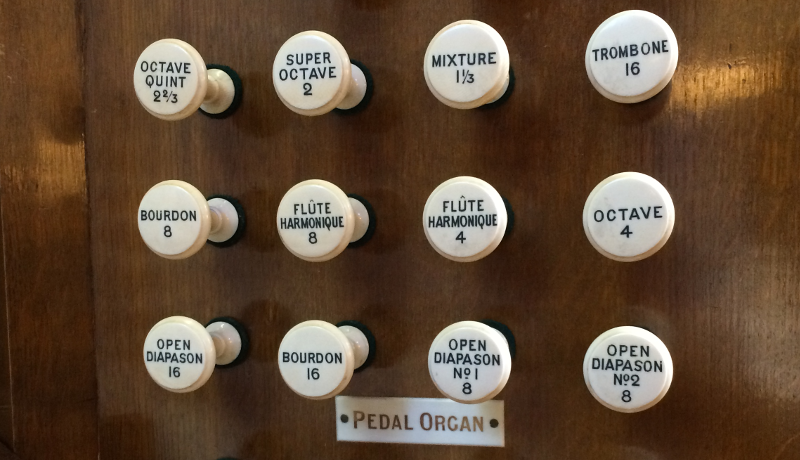
or tab stops, which need to be depressed.

Occasionally, the stops are rocking tablets which illuminate when active. This is fine until the bulb fails ....
Never mind the fanciful names of the stops. They each have a number which tells you the length of the longest pipe, so you know which sound at
concert pitch and which at other pitches. (As you can work out from the section above, stops labelled as 8-ft sound at concert pitch, as 4-ft sound an octave higher, as 16-ft and octave lower, and so on.
If in doubt,select just stops of 8-ft pitch. You can experiment using other pitches later.)
The stops which apply to any one manual are grouped together and, unless you are very unlucky, are labelled Great, or Swell etc. If there's no labelling (thankfully rare) it's vital to test the organ beforehand and hope for a good memory.
As mentioned above, the stops have many fanciful names and produce an amazing variety of tone colours and power. This is not the place to go into this in any depth.
Later, suggestions will be made for further information.
RETURN TO:
TOP
MENU - Organists Toolkit
MENU - Organists Online
Couplers
You will see some things which look like stops with a text like Swell to Great, or Choir to Great.
These are Couplers. When drawn or activated, by playing on the second named manual, you also play the active stops on the first named manual.
They are useful for quickly adding extra power, but can be ignored if you feel unsure about using them.
RETURN TO:
TOP
MENU - Organists Toolkit
MENU - Organists Online
Choosing Stops (1)
This section is for basic survival. It assumes that you have no experience and limited time to prepare. The information given here can be expanded upon by experimentation at any time.
(I am assuming that you, or someone who knows what's what, has switched the organ on. [There's many a book to be written about finding organ switches.])
- Identify the Great manual and draw an 8' stop, preferably one called Open Diapason. Test it - it should be moderately loud. Never, never, never, (unless you are experienced and know what you are doing [so why are you reading this page?]) choose just a 4' or a 2' stop.
- If it seems a bit quiet, also draw a 4' stop (Principal or Flute).
- You are now set up and could accompany a whole service just using these stops. It won't be exciting, but it will be safe.
- If time is on your side, identify the Swell Manual. Select an 8' stop and a 4' stop which (maybe) are a little quieter than those you have on the Great.
- You now have the opportunity, at natural gaps in the music, to change between the Great and Swell and thus have more variety.
RETURN TO:
TOP
MENU - Organists Toolkit
MENU - Organists Online
Choosing Stops (2)
This section is for those who have passed beyond basic survival. As a very general rule, the easiest way to get a louder sound is to
include stops at a higher pitch than you are already using. For instance, if you have already chosen an 8' stop, add one at 4' pitch;
if already using 8' and 4' stops, chose one at 2' pitch. And the reverse for getting quieter. Given time, it's always best to experiment a bit and find out what works well.
Here is an example played with just an 8' stop:
This time, it's played with 8' and 4' stops:
And finally with 8', 4'and 2' stops:
As mentioned above, some stops have fractional pipe-lengths, (known as MUTATIONS). These sound different notes to the one(s) being played.
For instance, a 2-2/3' stop sounds an octave and a fifth higher than played:
Here is an example based on Middle C on a 2-2/3' stop:
and a 1-3/5' stop sounds two octaves and a third higher.
Apart for specialised use, these add richness and colour to a combination of stops. HOWEVER, they can lead to some very strange sounds.
Unless you know what you are doing, or have time to experiment and listen, ignore them.
Some stops are named
Mixtures, and have Roman numerals instead of pipe-lengths. For each note you play, these stops add several high sounding notes.
Well used, they add clarity and power.
But, Unless you know what you are doing, or have time to experiment and listen, ignore them.
RETURN TO:
TOP
MENU - Organists Toolkit
MENU - Organists Online
Changing Stops (1)
As mentioned above, you can get variety by changing manual at natural gaps in the music. It is similarly possible to change stops,
either using the suggestions above or things you have found out for yourself. But:
- The rhythmic flow of the music must not be disturbed whilst you look for a stop to add or subtract;
- Without care, it's very easy to follow a stop-change with a flurry of wrong notes.
It's best NOT to change stops whilst holding a chord. This just leads to a bump in the music.
Here is a stop change, well managed, at a natural gap in the music:
Here is one with surprising bump in the sound, caused by changing stops whilst a chord is being held:
Here is one that destroys the rhythmic flow, caused by a search for different stops distracting the organist:
Gaps like this are often accentuated by a flurry of wrong notes as the organist throws him/herself back at playing.
RETURN TO:
TOP
MENU - Organists Toolkit
MENU - Organists Online
Changing Stops (2)
Some organs have Combination Pistons between the manuals,
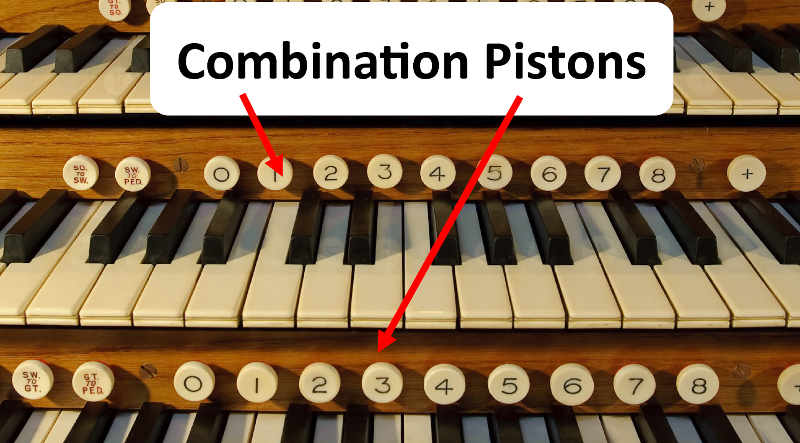
or above the pedals,
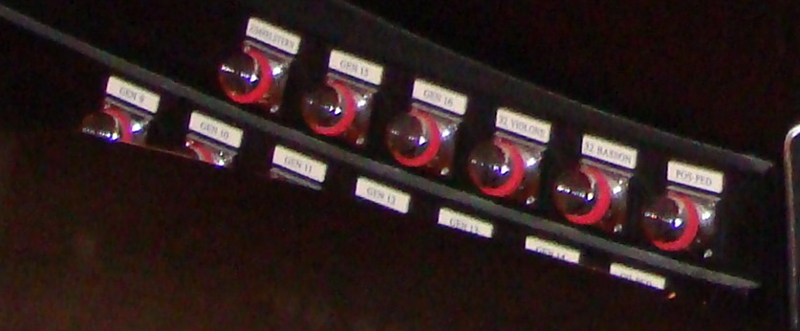
These activate groups of stops at the same time, and (if you feel confident) can be used in the same way as changing stops by hand. GENERALLY SPEAKING, they add extra stops from left to right,
but NOT ALWAYS.
Before using pistons, test them out to see what happens. They can be TOTALLY IGNORED if you prefer.
BEWARE!!!
BEWARE!!! BEWARE!!! If you use a combination piston, it MAY add some pedal stops. If your feet are resting on the pedals, you will get unexpected notes.
However, if you feel uncertain about choosing stops, the use of pistons usually gives you a good combination that sounds well.
RETURN TO:
TOP
MENU - Organists Toolkit
MENU - Organists Online
More about the Swell manual
(and the Choir manual)
Usually, the Swell manual and (sometimes) the Choir manual are said to be expressive. That is,
the pipes are tucked away in a box to reduce the sound but, by deployment of a pedal (not one of THE PEDALS - but something easy to use without training or practice), shutters are opened and more sound allowed out. These pedals may be Balanced (they stay where in the position where you leave them) or Trigger (they have to be latched open).
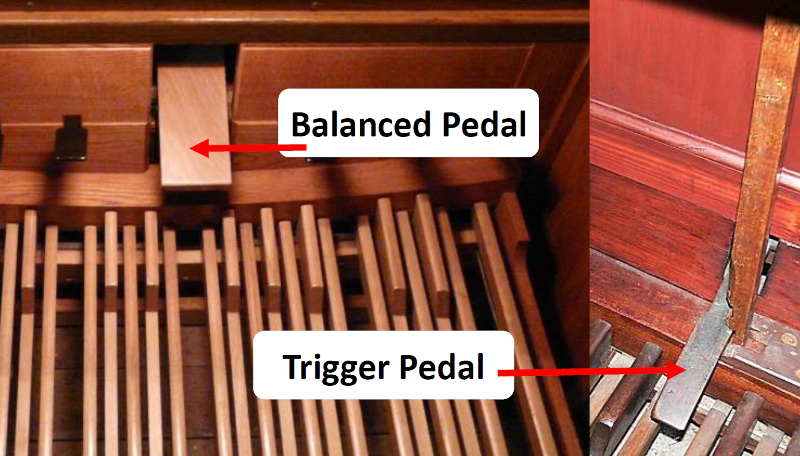
If there is more than one, and you are lucky, they may be labelled as to which manual they apply. If you get the chance, try them out beforehand.
It's not necessary to use these pedals and, if you choose not to, leave them in the open position (balanced - toe well forward, trigger - latched down).
BEWARE!!! BEWARE!!! BEWARE!!! Very occasionally, something that looks like a balanced swell pedal is a General Crescendo pedal and, if "open" brings on all the stops. Usually it's labelled but, if the organ has two or more unlabelled balanced pedals,
test them before playing and leave a general crescendo pedal in the "closed position" (heel well down).
Top flight professional organists can get caught out by a General Crescendo pedal, even when broadcasting live from the Royal Albert Hall.
You'll be please to know that the "Prommers" cheered and clapped and nobody really minded.
RETURN TO:
TOP
MENU - Organists Toolkit
MENU - Organists Online
Rare, but ...
This last section is here for the sake of completeness. Older organs (or more modern ones seeking to emulate older ones), or Continental inspired ones, can include some unusual features:
- The names of the manuals may be German or French (Oberwerk, or Positive etc). Try out a few notes to see which manual is which.
- The couplers may be little latch-down pedals above the main pedalboard.
- To save money on long pipes, some stops of 8' pitch will be missing their lowest octave. There will be one stop (with a name like "Stopped Diapason Bass") which supplies the missing notes.
This stop has to be drawn when using the short-range stops.
Other Pages
The second page includes information about actually playing with suggestions for getting round difficulties.
The third page includes links to useful repertoire and books for further study.
RETURN TO:
TOP
MENU - Organists Toolkit
MENU - Organists Online